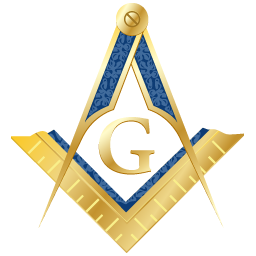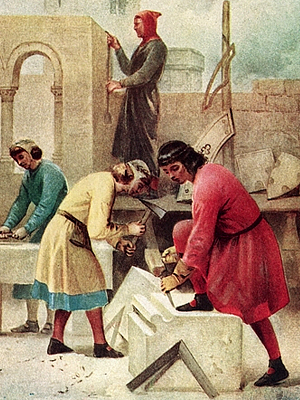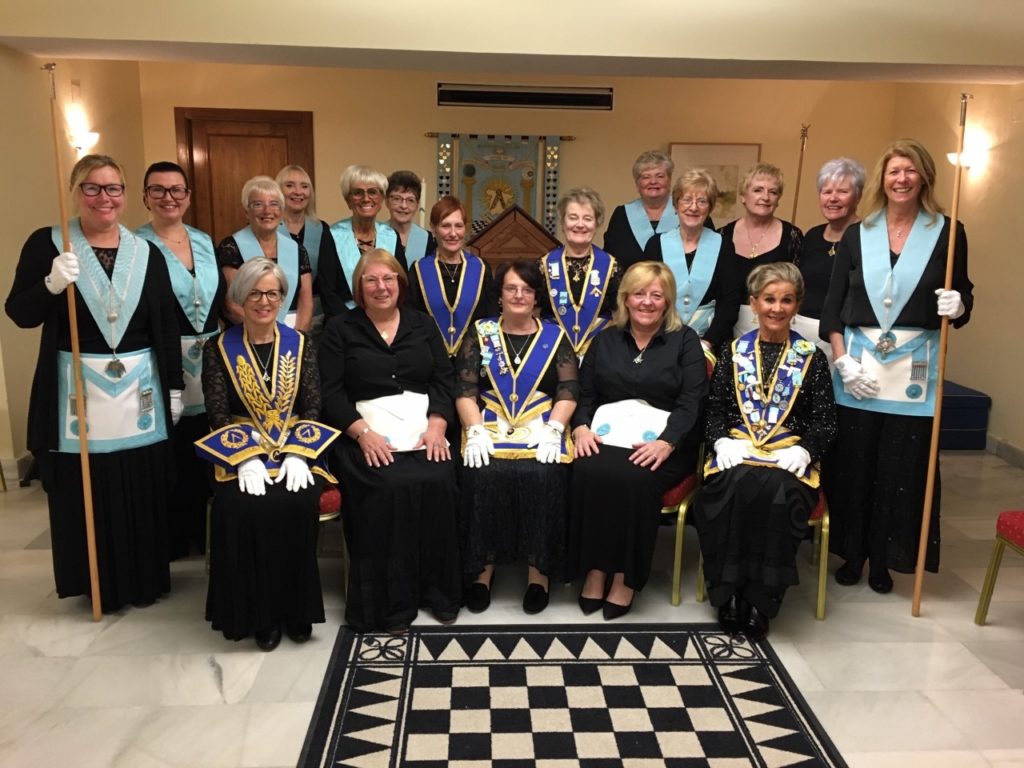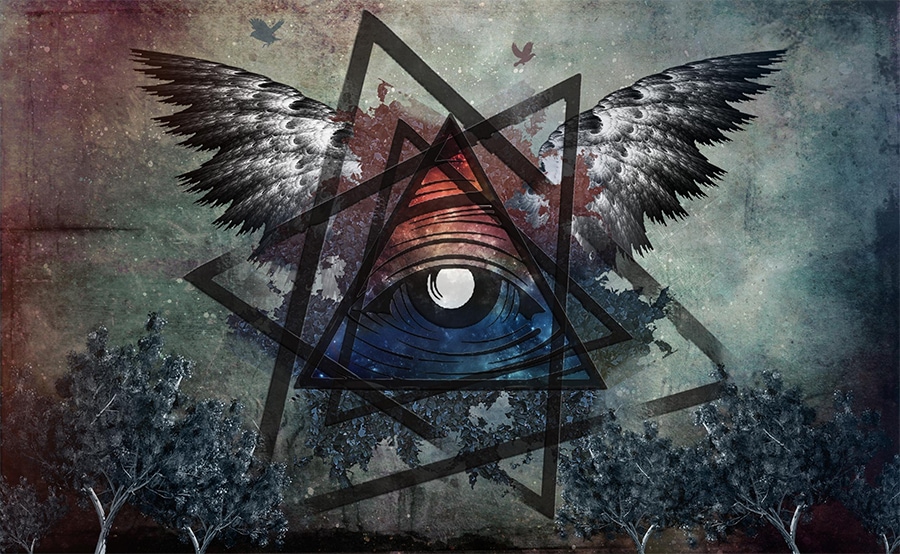What is Freemasonry?
None are shrouded in as much intrigue as the Freemasons when it comes to secret societies or even community interest groups. Dissecting Freemasonry is a conspiracy theorist's dream, with some laying the blame for the French Revolution, the assassination of JFK, and even World War One, at the door of the Freemasons.
But away from
rumour and speculation, we're going to take a look at what Freemasonry
actually is, how it evolved, and why people are attracted to join the
world's most popular fraternity. Let's begin by looking at what
Freemasonry is.
What is Freemasonry?
 Few
people dispute that Freemasonry is the leading fraternal organization
in the world. There are currently more than 3 million members worldwide,
with the highest concentration of just over 1 million members in North
America.
Few
people dispute that Freemasonry is the leading fraternal organization
in the world. There are currently more than 3 million members worldwide,
with the highest concentration of just over 1 million members in North
America.
Some sources claim there are more than 6 million members globally, but the likelihood is that the figure falls somewhere in between.
Freemasons come from a variety of faiths and backgrounds. They uniformly believe in the existence of a 'Supreme Being' and are concerned with the moral and spiritual values that are important in everyday life.
In particular, four crucial values help define a Freemason's path through life, namely: integrity, friendship, respect, and charity. A Freemason is expected to do his utmost to live true to these values and behave according to the fraternity code.
Additionally, every Freemason is encouraged to show interest and respect for his family and care for those in his society that are most in need. Being a Freemason is about understanding your place in society and actively contributing to building a better community.
During specially designed ceremonies and rituals, Freemasons are taught moral lessons and techniques for self-improvement. Following ancient guides laid down by the stonemasons, these rituals are symbolic and important, as they form a large part of the instructional element of what it means to be a Freemason.
Let's take a look at Freemasonry's roots and begin to understand how it evolved into the most popular fraternity in the world.
The History of Freemasonry
Freemasonry was first spread by the advance of the British Empire and has maintained its popularity in countries that were once members of the Empire.
 The
secret society evolved from the guilds of medieval stonemasons and
cathedral builders working in the Middle Ages. Much of the garb of
modern-day Freemasons is taken from the traditional uniform of the
stonemasons.
The
secret society evolved from the guilds of medieval stonemasons and
cathedral builders working in the Middle Ages. Much of the garb of
modern-day Freemasons is taken from the traditional uniform of the
stonemasons.
As cathedral building began to decline, many lodges that housed the stonemasons began accepting honorary members in order to increase the number of members. This was the first introduction of Freemasonry to the outside world.
During ceremonies and rituals performed at these lodges, secret handshakes, code words, and symbols were used to communicate in ways that were only understood by fellow Masons. This fostered a strong bond between Masons in the early days and even continues in lodges around the world today.
It was also from these lodges that the foundations of modern-day Freemasonry were laid. Much of the early eighteenth century's religious symbolism was captured in ceremonies at these lodges and remains an integral part of Freemasonry today.
Many Freemasons point to 1717 as the year of
the birth of the Freemasons, as it was the year in which the first Grand
Lodge, an association of several lodges, was founded in England, howeer
this refers only to the formation of a governing body. Speculative
Freemasonry (the admission of non-operative members to operative lodges)
had been practised in Scotland for more than a century prior to this
date.
Freemasonry and Religion
Throughout the eighteenth and nineteenth centuries, Freemasonry has received wide-ranging criticism from established religious bodies, especially from the Roman Catholic Church.
Freemasonry is technically a secular institution, although it is often mistaken for an offshoot of Christianity. It is true that Freemasonry teaches many elements of religion and encourages belief in a supreme being, but these teachings aren't exclusive.
One of Freemasonry's most essential requirements is that all applicants must believe in a supreme being and the soul's immortality. Of course, this is in line with most mainstream religions' teachings, so, understandably, people often become confused.
There have been instances in the past of certain lodges showing prejudice against Jews and even in the US towards non-whites, with the vast majority of members coming from the Protestant church. However, inclusivity is of significant importance to Freemasons, and lodges today are diverse and mostly welcoming environments.
Without getting too caught up in it, Freemasons are expected to have faith, but the fraternity does not seek to replace a Mason's religion. Freemasonry, in general, deals with a man's relationship with fellow men and not their relationship with God.
Although belief in a supreme being is a necessary precursor for those seeking to join, and many ceremonies and rituals are laced with religious symbolism, Freemasonry itself is not, as many mistakenly think, a religious institution.
Regarding ceremonies and rituals that are conducted at Masonic lodges, they are similar in form to the gathering of any other society or community interest group. A register is called, minutes are taken, and updates on charitable and social events are shared and discussed openly by all members in attendance.
However, it is not the regular meetings that capture the outside world's attention; it is the secret ceremonies in which members are initiated which inspire the imagination.
It is widely known that, during initiation ceremonies, a series of structured ritual dramas are used to educate new recruits on the inner workings of Freemasonry. These rituals are unique and spectacular and feature ceremonial garb and much symbolism that is unique to the lodge and the brotherhood of Freemasons more generally.
As a Mason, you are expected to participate in both general meetings and ceremonies. Your attendance is an integral part of your journey from Entered Apprentice through to the hierarchy of the Freemasonry Brotherhood.
Freemasonry and Women

Freemasonry is widely renowned for being for men only, but that isn't actually the case. The first female-only lodge opened in 1908, and women currently have two separate grand lodges: the Honourable Fraternity of Ancient Freemasons and the Order of Women Freemasons.
The female lodges follow the same ceremonies and wear the same regalia as male Freemasons. However, Freemasonry's relationship with women has not been straightforward, with many viewing the institution's attitude towards women as un-necessarily chauvinistic and regressive.
In 2018 and in line with the changing world in which we live, the United Grand Lodge of England issued a gender reassignment policy. The policy stated that you must be a man to join the Freemasons, but if you wish to change your gender and become a woman during your time there, you will remain a member. This was seen as a positive step forward in the trans community.
Freemasons and the Illuminati

We've already mentioned Freemasons and the conspiracy theorists in this post, but there's one name that sticks out when we think about Freemasonry in popular culture: the Illuminati.
The Illuminati is understood to be the shadowy cabal of influential individuals who direct global affairs and manipulate financial markets in their favor, essentially creating a governance system that supports those at the top while neglecting those at the bottom.
A secret society originally formed
in 18th century Bavaria, conspiracy theorists have contributed almost
every devastating event in modern times to the Illuminati in one way or
another, and their secret nature has given rise to a cult-like following
of enthusiasts who utilize their secrecy as something by which to be
infatuated. The original society was disbanded within a few years of
its founding.
This is in direct opposition to Freemasonry's commitment to charitable causes and the importance of their values as a fraternity. Other than conjecture and some creative articles and videos, there is no concrete evidence to support a link between Freemasonry and the Illuminati.
Freemasonry Today
Part of Freemasonry's allure and charm is its historical symbolism, although many people feel that it is outdated, given the many advancements in the modern-day. That being said, lodges across the world still participate in many of the ceremonies and rituals that were popular amongst the early stonemasons.
In 1999 the Lodge of Edinburgh (May's Chapel) celebrated the Quatercentenary of their earliest Minute of 1599. In 2017, the United Grand Lodge of England celebrated its 300th anniversary, and there's no indication that membership numbers will dwindle in the near future. The once-secret society has now taken to social media to engage with current and potential members, and you can find a lot of information online about their ceremonies and rituals.
Masons were not allowed to share details of their practices with anyone outside the lodge in days gone by. Still, the advent of modern technology and the Internet, in particular, has made it challenging to keep a lid on the Freemason fraternity's secret inner workings.
Conclusion: What is Freemasonry?
Evolved from the social lodges of early stonemasons in the middle ages, modern-day Freemasonry is about encouraging men to be the best versions of themselves while contributing positively to their society and upholding a belief in a superior being.
Freemasonry's secrecy has given rise to many popular conspiracy theories about its structure and members, most of which are unfounded.
The fraternity has taken steps towards modernization in recent years while staying true to many of its historical symbolism and important values.
Overall, to this day, Freemasonry continues to be popular in countries worldwide. This is likely to continue as the lodges look to modernize in ways that acknowledge the advent of new technology while protecting the institution's traditions and heritage.